Last week I wrote about what combustion air ducts are and why houses need them. This week I will follow up with some of the most common problems and solutions related to combustion air duct installation and maintenance.
By far, the most common problem that occurs with combustion air ducts is that they get blocked. When a combustion air duct is blocked, air needs to “leak” into the house through many different undesirable pathways. I’ve done a number of home inspections where the windows were completely iced shut throughout the house, and in every case, there was a blocked combustion air duct.
Problem: Intentional, ignorant blockage
A combustion air duct brings in fresh outdoor air, which usually means cold outdoor air in Minnesota. This can create a cold floor where the duct terminates and a cold draft. Check out the two images below for a nice visual of how the combustion air duct makes my basement floor cold.
To prevent this cold air from dumping into their home, people sometimes stuff clothes or towels into the combustion air duct or block the intake at the home’s exterior.
Solution: Remove any obstructions. If you want to help cut down on the amount of cold air that dumps down into the basement, try creating a trap at the bottom of the combustion air duct. Make the air have to rise up again before entering the home. I don’t have any hardcore proof that this makes a big difference, but I’ve convinced myself that it helps, and it’s easy enough to do. The two most common ways of creating a trap are to either make a “J” at the bottom of the duct or put a bucket or box underneath the duct. With either of these methods, the air must rise up before entering the home.
Just make sure that the bucket or box you use isn’t so small that it restricts airflow. I’ve always just eyeballed this, but if you’re super anal, you could make your sixth-grade math pay off by measuring the inside diameter of the bucket and the outside diameter of the duct, then calculate the surface areas (πr²) and make sure the bucket has at least twice as much as the duct.
Also, make sure the duct isn’t so long that the opening sits flat on the floor, effectively blocking it.
Problem: Lack of maintenance
The opening at the exterior for the combustion air duct will bring air into the home, and with that comes dust, dirt, insects, leaves, etc. The closer the combustion air duct is to the ground, the more likely it’ll get blocked with debris.
Solution: take a peek underneath your combustion air duct every year to make sure it stays clean. If you do this during the summer or fall, watch out for wasps. They love to make nests in this opening. If the opening is dirty, vacuum it off with a wet/dry vac. If you have an air exchanger, check the intake at the same time. The intakes are usually right next to each other, and they’re typically indistinguishable.
Problem: Small Mesh at the Exterior
The opening at the exterior of the home needs to be covered with a steel mesh having openings not less than 1/4″. When insect screen is used here, it will get dirty very quickly. Click on the photo below for a larger view; you’ll see the opening is actually covered with an insect screen, which should be removed.
Solution: Remove any restrictive mesh or material, and replace it with 1/4″ hardware cloth or something similar if it’s not already present.
Problem: Unintentional, ignorant blockage
Every so often, vinyl siding installers will forget which opening was meant for the combustion air intake, and they’ll install a damper at this opening instead of a screen. These dampers allow air out, not in.
Solution: Replace the exterior terminal with a type designed for a combustion air intake, or remove the damper and cover the opening with 1/4″ hardware cloth.
Problem: Inlet installed too close to the ground
The inlet for a combustion air duct needs to be installed at least 12″ above grade. When it’s too close to the ground, it can get dirty quickly and get blocked over with snow.
Solution: When the combustion air inlet is installed this close to the ground, it’s usually done because that’s where the rim joist was located, so making a higher hole in the side of the house isn’t an option. The solution is to install a snorkel. I think the photo below is pretty self-explanatory. Unfortunately, I don’t know where to purchase one of these contraptions. The HVAC contractors I’ve talked to said they make their own.
That concludes my list of the most common installation and maintenance defects with combustion air ducts.
Related Posts:
- Combustion Air Ducts, Part I: Why Houses Need Them
- Combustion Air Duct Connected to the Return Plenum
Quick links in this post: Blocked duct at interior, dirty intake at exterior, small mesh at exterior, blocked intake at exterior, intake installed too low, cut down on cold air coming in.

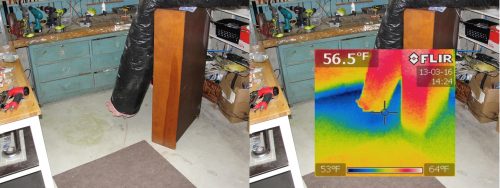
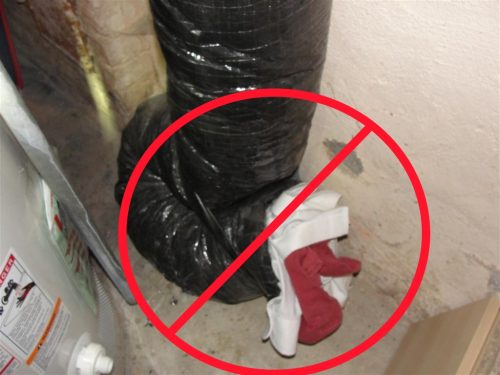
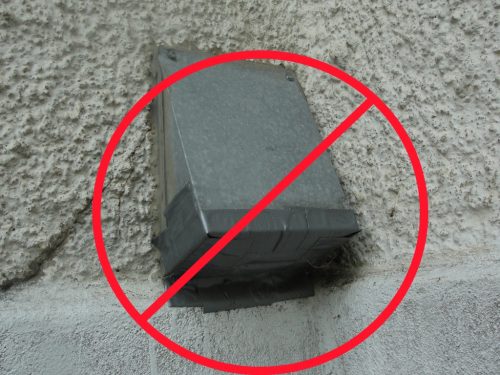
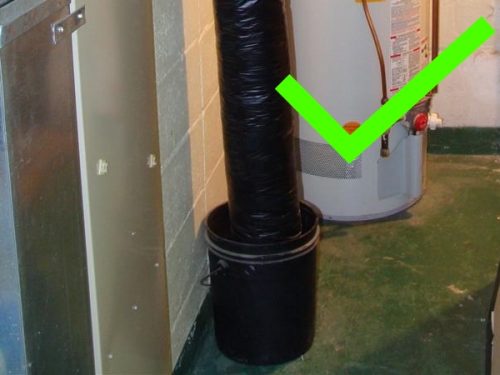
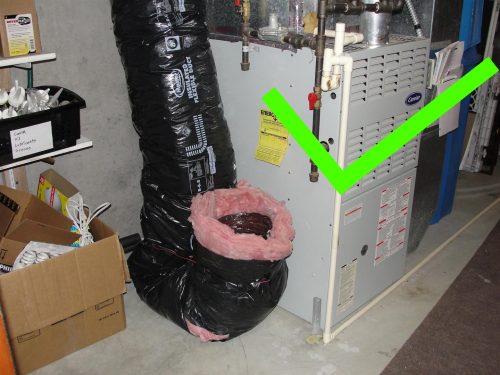
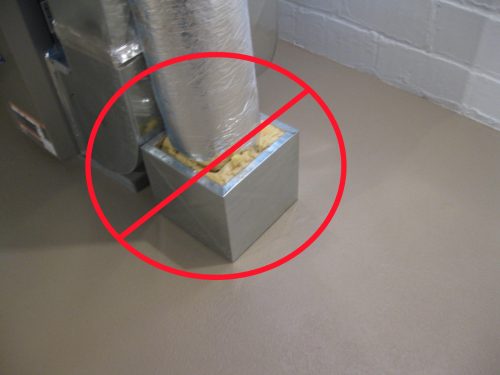
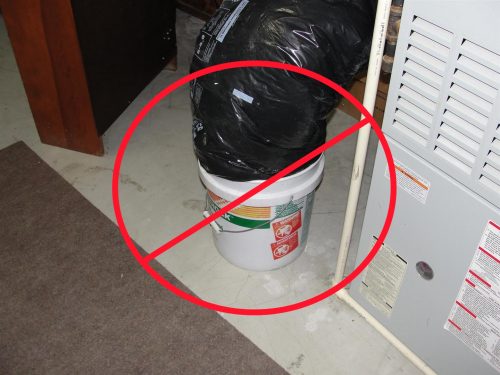
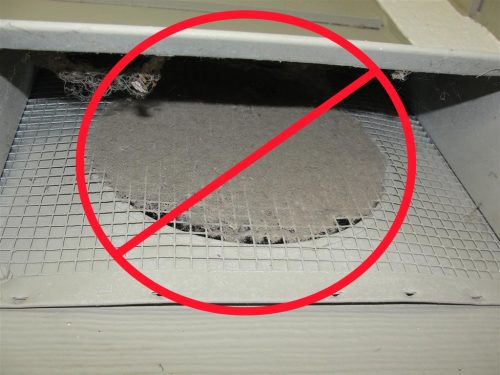
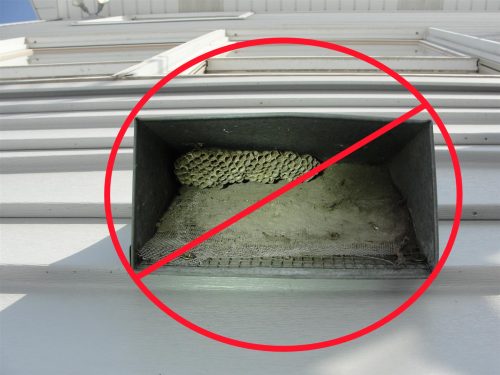
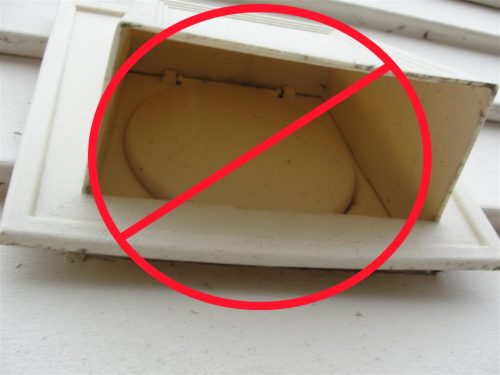
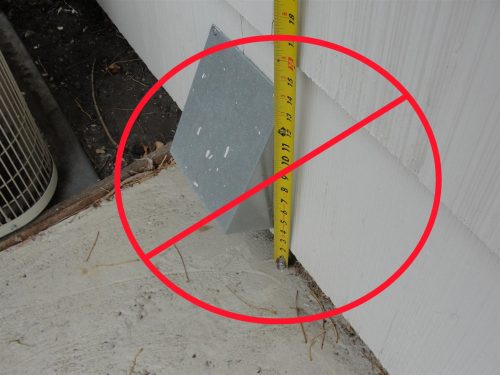
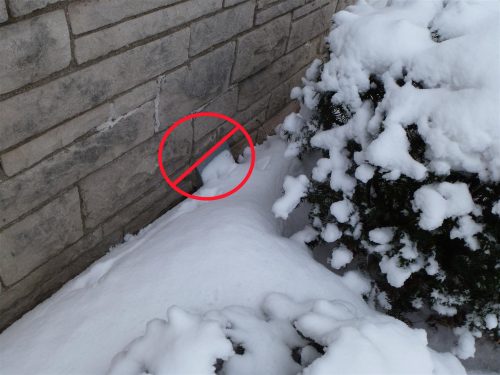
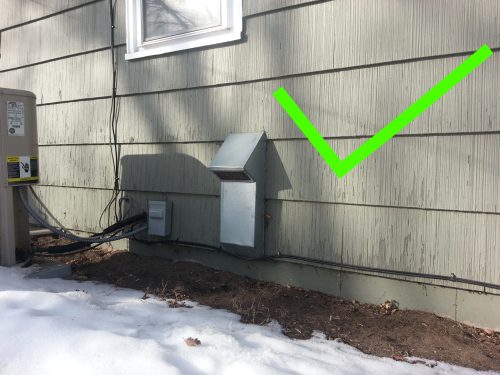
Aaron
March 28, 2013, 5:55 am
What about connecting the duct to the cold air return of the furnace? That was done in my house when I moved in but someone told me it was better to have it in a bucket, as you suggest. But putting it in the cold air return seemed to make sense to avoid cold air in the house. Any comment? Thanks.
Reuben Saltzman
March 28, 2013, 7:16 am
Aaron – I plan to follow up with a post on that specific topic. Probably not next week, but hopefully in the near future. I agree, it’s better to disconnect the duct from the furnace ductwork. When it goes to the return plenum on the furnace, you end up pulling cold air in to your house.
Aaron
March 28, 2013, 7:43 am
Thanks, I’l look forward to it!
Bill
April 7, 2013, 12:37 pm
Reuben,
thanks for this informative write up! about a year ago we put in a new HE furnace and drew combustion air from outside instead of from in the basement where it was drawn before. Thought this would be more efficient and keep house fresher but since then have noticed a ton of dust accumulating on upper surfaces (walls, cabinets etc). Now my wife wants me to switch back to drawing from inside. Our outside draw is 4″ PVC, goosenecked over, similar to the exhaust pipe. Do you think that the outside air the cause of my dust problem?
Reuben Saltzman
April 7, 2013, 1:51 pm
Hi Bill, if you have a high-efficiency furnace taking it’s combustion air from the exterior, you should keep it that way. That’s the most efficient way to do it, and shouldn’t be related to any dust problems.
Graham Smith
April 29, 2013, 8:15 pm
Rueben, great post. One scenario that is worth discussing is the need for a combustion air duct when both the furnace and water heater are direct vent/high efficiency models. I have had a handful of contractors explain that combustion air is not necessary when both of these devices are high efficiency models with direct venting. However, I have also been told that the combustion air is still required, as most folks have other natural gas devices in their home such as a stove top or an oven in their kitchen. In your opinion, which theory is correct? For the sake of full disclosure, the folks that have explained that the combustion air is not neccessary, are usually contractors/property flippers selling a home that currently does not have a fresh air intake duct.
Reuben Saltzman
April 30, 2013, 3:48 am
Hi Graham,
A true ‘direct vent’ appliance obtains all of it’s combustion air directly from the exterior. In the case of a furnace, that’s a very common setup. The furnace will have two pipes; one for combustion air and another for exhaust gas.
A direct vent water heater is very rare in Minnesota. I’ve probably seen less than a dozen, ever. What’s commonly used here is a powervent water heater; these have a one-pipe exhaust that forces the exhaust air out the side of the building, but they still obtain their combustion air from inside the home, so a combustion air source is still needed.
It’s ultimately up to the building official to decide whether a combustion air duct is needed in the scenario you describe. I’d say it’s better to have one for the reasons you mention, but it’s probably not critical.
Brian
July 20, 2013, 2:30 pm
Hi Reuben,
I live over here in beautiful Bloomington, MN. I am getting ready to move the output end of the combustion intake from my return plenum to the basement floor. Only problem is I have a big laundry cabinet/table directly under the intake. I was wondering if there is a reason the flex duct must terminate at the floor or is it ok if the duct terminates above the cabinet? This would be a drop of about 4 feet from the outdoor inlet.
Reuben Saltzman
July 21, 2013, 5:58 am
Hi Brian,
The combustion air duct doesn’t have to terminate at the floor, but this will help to reduce the amount of cold air that dumps into the room. My suggestion would be to get some more flex duct and extend your existing duct.
Combustion Air Ducts, Part I: Why Houses Need Them | Structure Tech Home Inspections
September 30, 2013, 4:02 am
[…] Combustion Air Ducts, Part II: Problems and Solutions […]
Combustion Air Duct Connected to the Return Plenum | Structure Tech Home Inspections
September 30, 2013, 4:05 am
[…] of my recent blog posts have been about the need for combustion air ducts and common problems with combustion air ducts, but I never covered the topic of connecting a combustion air duct directly to the plenum on a […]
Water Heater Backdrafting, Part 2 of 2: Why It's Happening and How To Fix It | Structure Tech Home Inspections
October 1, 2013, 3:43 am
[…] of houses. If there is already a combustion air duct installed, they’ll make sure the intake is clean at the exterior and the duct is not obstructed. If that all looks good, they might install a makeup air duct; […]
Cathy
October 5, 2013, 7:22 pm
I live near Winnipeg, Manitoba Canada. Our HRV inlets and outlets are too close to the ground as you show. I am having a difficult time finding a “Milind” on the net. What type of establishment should I be looking for them at? I’m assuming I would only need it for the inlet since the outlet is pushing air out. Thank you for this information.
Joe
October 23, 2013, 1:37 pm
Is it posible to filter the air as it comes into the house? If so, what would be a good materail to use? Wouldn’t want to be installing a Bug highway. We have a vast number of the litle buggers in ND.
Thanks, Joe
Reuben Saltzman
October 23, 2013, 2:27 pm
@Joe – not to code, however… installing an insect screen at the inlet would do a great job of keeping out pests. It will also get dirty very quickly. If you clean it off every month, it would probably work fine.
Tom Secrest
October 24, 2013, 8:00 pm
How can I filter the fresh air intake to my furnace. My wife has alot of lung/health problem. Need to clean the air as much as possible.
Thanks,
Reuben Saltzman
October 26, 2013, 3:52 am
@Tom – I don’t have any suggestions. I’ve never seen a filter on a combustion air intake.
Jeremy
October 25, 2013, 10:12 pm
Reuben,
Thank you for these helpful posts! I’m wondering A) whether a certain material (metal?) is required for a combustion air duct to be to code, or if PVC can be used, and B) whether 4 inch diameter would be sufficient for a utility room w/ hot water boiler + water heater in a 1,200 square foot residence (unsure of btu rating on boiler).
Reuben Saltzman
October 26, 2013, 3:56 am
@Jeremy – I’m not aware of any material requirement. PVC would work fine. As for sizing the combustion air duct, you would need to check with your local building official. You would need to know the BTU ratings of the appliances as well as the size of the room they’re located in to get an answer.
My guess would be yes, 4″ PVC would probably work fine.
Cathy
October 26, 2013, 6:19 pm
Still waiting to find out what the “snorkel” is really called and where I can buy one.
Reuben Saltzman
October 26, 2013, 6:22 pm
@Kathy – as soon as I find out, I’ll definitely share the info here.
Keith
December 6, 2013, 2:12 pm
I recently moved into a 1983 house. Two floors and a walkout basement. Furnace is in the basement and is high-efficiency. Whenever the furnace fan is running, I notice cold air being dumped into the furnace room via combustion air vent. It’s not a huge amount of air but it is noticeably cold and consistent (we like to run the furnace fan on low 24 hrs). There is no HRV/ERV. This happens when the furnace is not heating, the water heater is not on, bathroom/kitchen ventilation fans are not on, clothes dryer is not on, etc. Just the circulating fan in the furnace is running. There is a single door to the basement (i.e. it is not open to the main floor). Does this mean my HVAC system is not balanced correctly?
Reuben Saltzman
December 6, 2013, 2:16 pm
@Keith – yes, it sounds like your system isn’t balanced properly. It might also just be some very leaky return ductwork.
Carla
December 9, 2013, 5:35 am
Hello Rueben,
I had a Coleman, High efficiency furnace installed about 6 years ago. Ever since, I have been chilly almost constantly. The room fluctuates in temperature. I just had an epiphany. Cover the cold air returns. I have an older home “1942” asbestose siding. The vents are around the perimeter of the house, and are very leaky. (I know from observation via the camera inspection from the vent cleaner. I could see daylight.) So I decided to cover the vents. It has stopped the draftiness an seems to be a bit warmer. The furnace has a 4″ direct vent into the furnace downstairs. The livingroom and kitchen are opened to each other. Can’t I just leave my bedroom doors opened? It seems to be better without that drafty cold air coming in through the cold air vents from the outside. The main point is to have circulation, is it not? Don’t tell me to remodel. That isn’t going to happen.
Reuben Saltzman
December 14, 2013, 6:19 am
@Carla – covering all of your return vents will choke off all of the air that’s supposed to be coming into your furnace, making the air coming out of your furnace much warmer, and will make it so your furnace only uses outdoor air for return air; it will all be air leaking in through those holes in your ductwork. This will dramatically reduce the efficiency of your system, shorten the life of your furnace, void the warranty on your furnace, and cause your furnace to short cycle, which will lead to service calls.
I won’t tell you what to do though… because it ain’t gonna happen 😉
henry gillich
December 13, 2013, 3:15 pm
I live in Winnipeg, cold cold!!!
Had a Lennox HE furnace installed a year ago and the comdustion air PVC is icing up on the outside of the pipe inside the basement. Water was running down the finished walls. Installer has installed insulated tubing around the pipe but water is still coming in.Humidity levels are around 25%. Any suggestions would be greatly appreciated. As I now will have rip out the affected wall.
Would a heat tape of 3-6 watts wrapped around the pipe be a reasonable solution.
Reuben Saltzman
December 14, 2013, 5:46 am
@Henry – I’ve never seen anything like that happen. If guess if it were me, I’d try putting more insulation around the inlet pipe first.
Ernest Reed
December 16, 2013, 8:43 am
Just had a new HE furnace installed this past summer. Both intake and exhaust were placed in new holes that, when outside, the intake stands only 8 inches above grade (the exhaust is about a 16 inches above that). I asked the installer if he could extend the air intake higher with consideration of snow and he said it would not be a problem. The real problem is that its between a deck and fence and accessing it to clear snow is very difficult. Last week, before the real snow came, I regraded the ground and have now got 14 inches clearance, but am still concerned that its not enough. Any suggestions, with consideration the furnace installers are not keen on extending the intake pipe?
Ernest Reed
December 16, 2013, 8:48 am
Had a new HE furnace installed this past summer. Two new pipes now protrude out the back of the house, between a fence and deck, with the intake only 8 inches above the ground and the exhaust some 16 inches higher. At the time I asked the installer why he could not extend the intake higher, with consideration for snow, and he indicated that it would not be a problem. Last week, before the real snow arrived, I regraded the ground around it and bought myself an additional 6 inches. I’m still very concerned because I cannot easily access the intake pipe to clear the snow. The company says they cannot do anything further and it is what it is. Any suggestions? Something I can myself (extend the pipe upwards and elbow down)?
Reuben Saltzman
December 16, 2013, 12:57 pm
Hi Ernest, I recommend contacting your manufacturer. Sometimes it works to extend the pipe up, but your manufacturer may not be ok with that.
Chris
December 17, 2013, 3:47 pm
I have a high efficiency direct vent furnance and am having issues with the the wire mesh on the intake pvc pipe getting covered in snow and susequently shutting the furnace off. the intake pipe runs paralel and about 2 feet off the ground. My neighbour’s house is about 3 feet away from my house on the same side. I am fairly confident the issue is that the exhaust pipes (on both my furnace and possibly my neighbour’s furnace) become mini snow-makers on extremely cold days and hence are the source of my problem. The question is how to prevent the intake pipe from getting clogged by this snow that is generated by the furnace exhaust pipes? I have tried multiple things, such as putting pvc elbows and extensions on the intake pipe. Should I put an elbow with a 2 foot extension with another elbow on the intake to try to deal with this…or will this solution not let in enough air? Should I be putting some kind of extension on the exhaust pipes to redirect the exhaust away from the intake? HELP!! Thanks…!!
Reuben Saltzman
December 18, 2013, 4:25 am
Hi Chris, see my comment to Ernest on 12/16. I’m not qualified to re-design high efficiency furnace intake and exhaust vents. Enlarging the size of the intake surely couldn’t hurt, but that’s about all I can think of.
Denise Steinberg
December 20, 2013, 11:38 am
My HVAC contractor just installed two makeup air vents in a space with my older non-high efficiency furnace made out of large galvanized pipe, one high, one low, which both bring in freezing cold air (Denver). They are vented outside but the galvanized pipes condensated and froze near the end source and exterior wall. What can be done to mitigate the condensation. Also, the contractor suggested enclosing the furnace and HWH with a wall to stop the freezing cold air from penetrating the rest of the basement. Help!
Reuben Saltzman
December 20, 2013, 12:41 pm
@Denise – replacing the metal ducts with insulated flex / plastic ducts would certainly help. Replacing your old furnace with a new high efficiency, sealed combustion furnace would help even more.
Dan fabeck
May 23, 2023, 10:30 am
We have a second story mechanical room. Furnace(gas) and hot water heater(gas,power vent) in there. I see no combustion air intake in the room. But we have the house air exchange system in there. Does that replace the combustion air intake needs?
Reuben Saltzman
May 23, 2023, 12:36 pm
Hi Dan, no, the air axchange system does not replace the need for a combustion air duct. The air exchanger should be balanced to have neither a positive or negative pressure effect on the home.